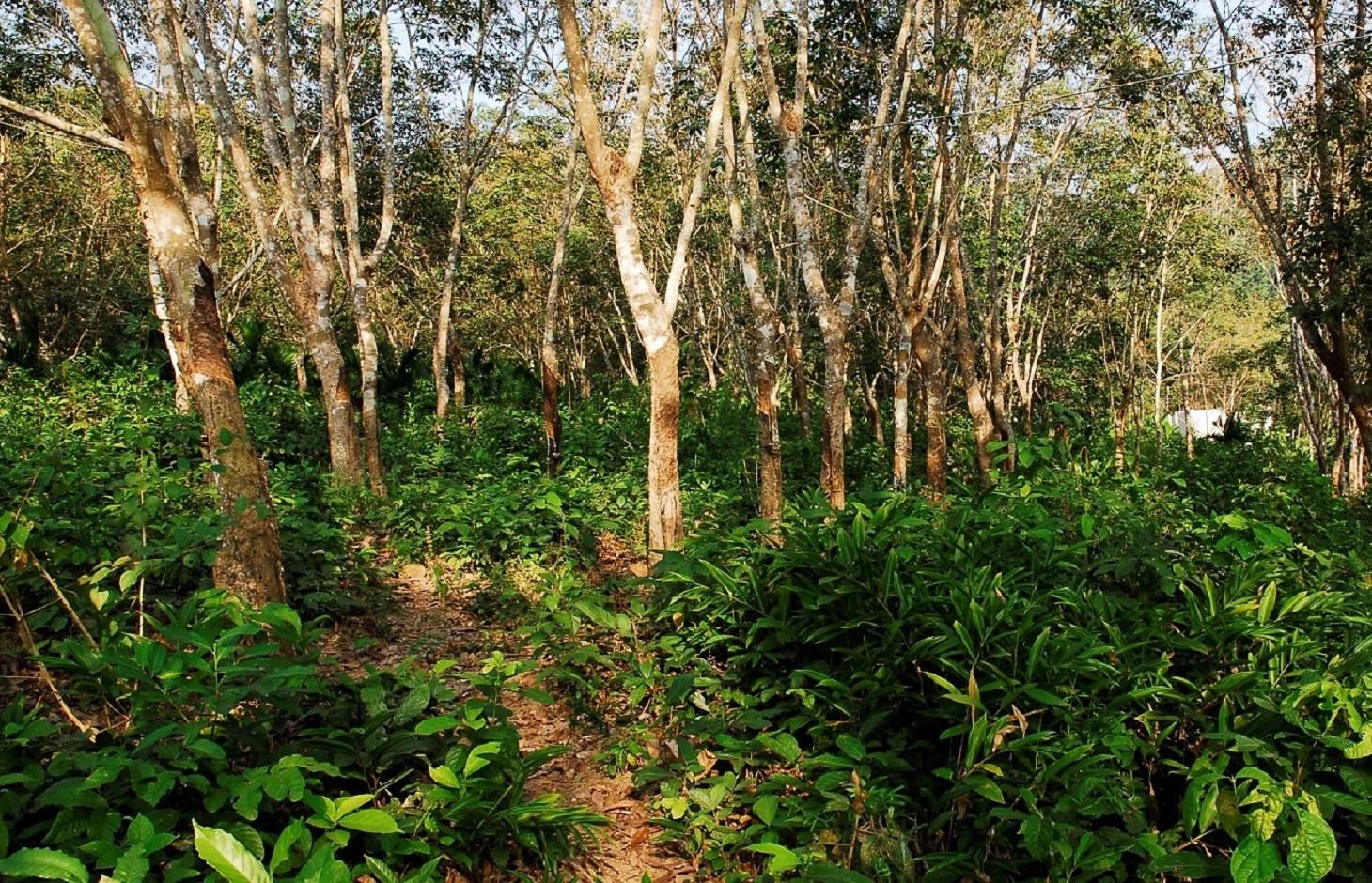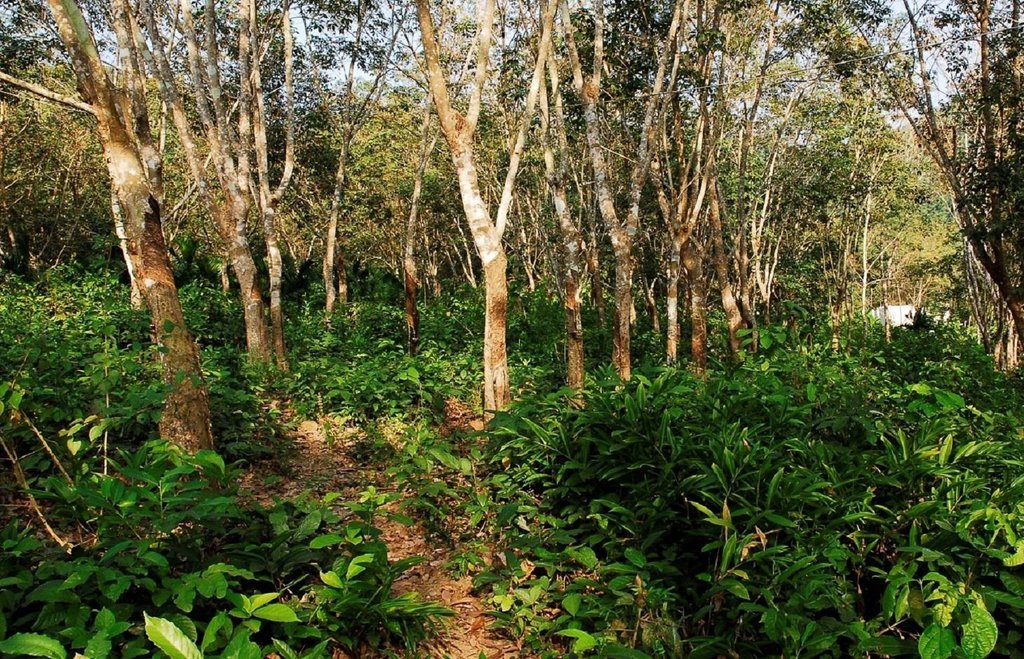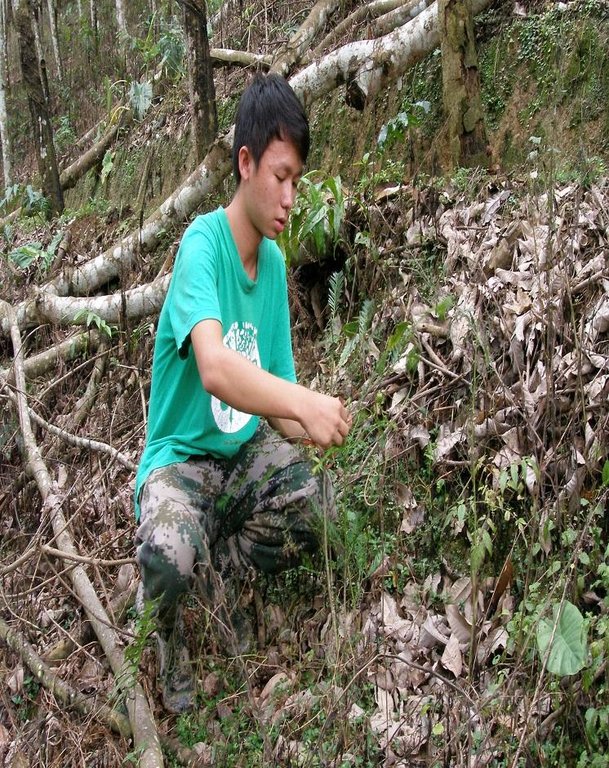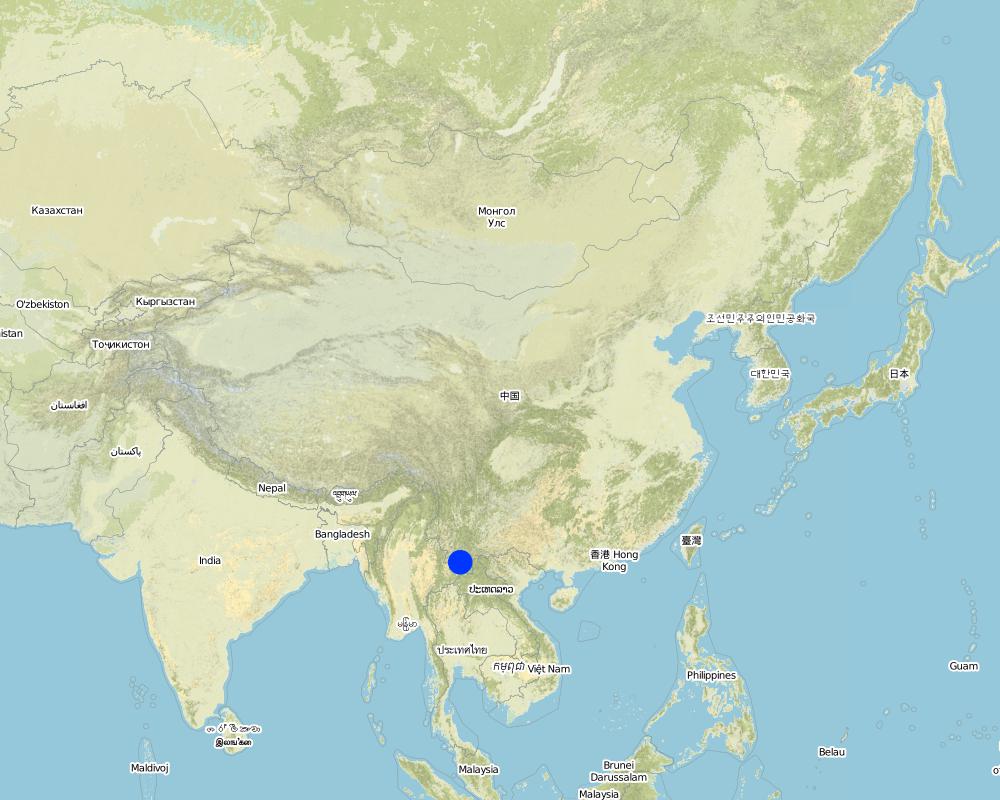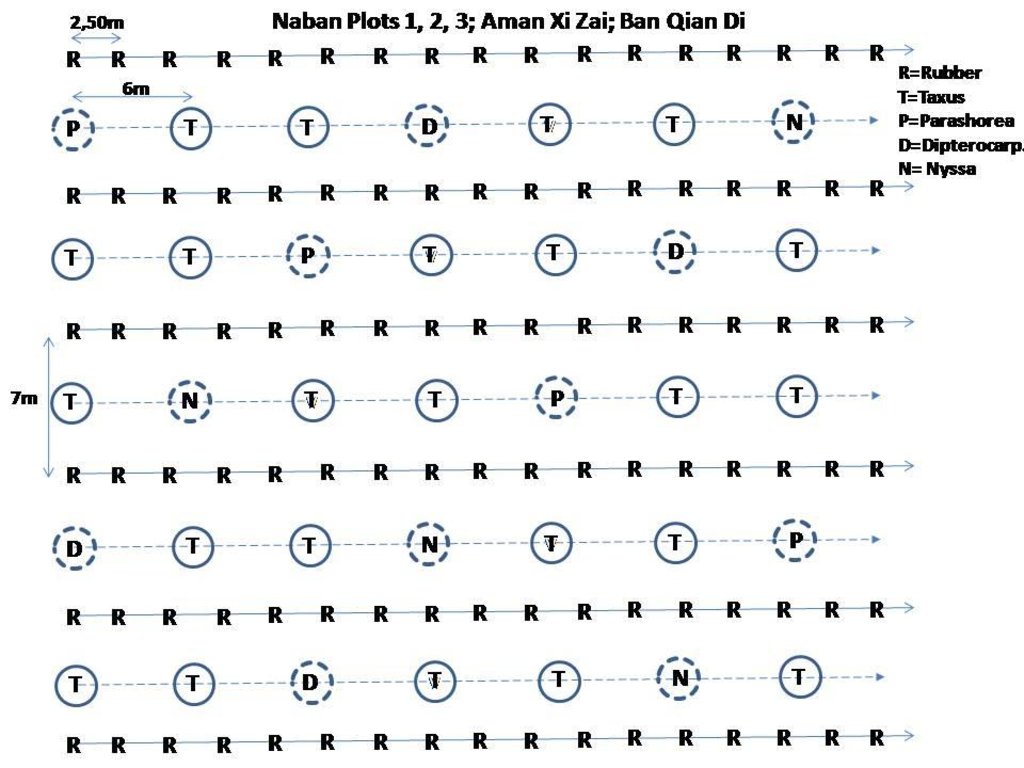Integrating native trees in rubber monocultures [Китай]
- Создание:
- Обновить:
- Составитель: Gerhard Langenberger
- Редактор: –
- Рецензенты: Deborah Niggli, Alexandra Gavilano
减缓单一橡胶种植的负面环境影响:关于橡胶与当地树种混种并结合杂草管理的生态种植研究 (Chinese)
technologies_1717 - Китай
Просмотреть разделы
Развернуть все Свернуть все1. Общая информация
1.2 Контактные данные специалистов и организаций, участвующих в описании и оценке Технологии
Специалист по УЗП:
Специалист по УЗП:
Blagodatsky Sergey
University of Hohenheim
Германия
Название проекта, содействовавшего документированию/оценке Технологии (если применимо)
Book project: Making sense of research for sustainable land management (GLUES)Название организации (-ий), содействовавших документированию/оценке Технологии (если применимо)
Humboldt Universität zu Berlin (HU Berlin) - ГерманияНазвание организации (-ий), содействовавших документированию/оценке Технологии (если применимо)
Universität Hohenheim - ГерманияНазвание организации (-ий), содействовавших документированию/оценке Технологии (если применимо)
China Agricultural University (China Agricultural University) - Китай1.3 Условия, регламентирующие использование данных, собранных ВОКАТ
Составитель и ответственный(-ые) специалист(-ы) согласны с условиями, регламентирующими использование собранных ВОКАТ данных:
Да
1.4 Декларация по устойчивости описываемой Технологии
Вызывает ли описанная здесь Технология проблемы деградации земель настолько, что ее нельзя назвать природосберегающей?
Нет
2. Описание Технологии УЗП
2.1 Краткое описание Технологии
Определение Технологии:
The technology combines the integration of native tree species into rubber monocultures with changed weed management to mitigate negative environmental impacts and to provide alternative income options for farmers.
2.2 Подробное описание Технологии
Описание:
Natural rubber is a crucial renewable resource produced from the tree Hevea brasiliensis. Production is largely based on monoculture, often associated with chemical-based clean-weeding. This causes environmental problems such as loss of biodiversity, pesticide pollution and erosion of topsoil. The SLM-technology aims at mitigating negative impacts by interplanting the rubber with native tree species which have economic potential of their own. Changes in weed management are part of the package also.
Native (indigenous) tree species are integrated into mature rubber plantations. Criteria for species selection are: a) adapted to environmental conditions; b) shade tolerant; c) vertical growth not affected by light; d) conservation value; e) economic potential; f) easy to manage. Rubber trees are usually planted in rows at a spacing of 6-8 m, and an intra-row distance of 2.5 to 3 m. The native trees are planted between the rubber rows. The plantation should be mature as the canopy will have reached its highest density, and weed competition is naturally suppressed. The spacing of the native trees needs to be adapted to their growth potential and intended usage. After planting, regular monitoring is necessary to identify pests or diseases. The following species were selected for demonstration sites: 1) Parashorea chinensis, a valuable timber tree, 2) Taxus mairei, a multi-purpose tree, providing good timber but also an anti-cancer drug, taxol, and 3) Nyssa yunnanensis, selected for its conservation value. At the end of the economic life span of the rubber trees (about 30 years) there will be several options, but there are three main ones. First the rubber plantation can be replanted, although the harvest of the Parashorea chinensis trees would be premature. The Taxus mairei trees could be maintained through a new plantation cycle. Second, both, the rubber and the intercropped trees could be maintained for future timber and taxol production. Third, the plantation could be transformed into a sustainable forest managed scheme where the rubber trees are extracted step by step and the intercropped trees maintained for their intrinsic value.
Procedures for the selection and planting of the indigenous tree species are crucial. Identification should be based on suitability for the climate and soil as well as economic potential. The raising of tree seedlings requires experience and nursery propagation by experts might be required. Only healthy seedlings should be used. Planting should take place during rainy periods. Potted seedlings are better than bare-rooted seedlings since they establish better. Generally, weed management (if necessary) should shift from herbicide application to mechanical weeding. Grass competition needs to be avoided in any case! Controlled cover of natural undergrowth will reduce erosion and promote water infiltration.
The implementation site for the trials is located in Xishuangbanna Prefecture, Yunnan Province, SW China. The original vegetation was tropical rain and monsoon forest, but now there is a rich mosaic of different land-use and vegetation types. The whole region is exceptionally species rich and part of the Indo-Burma-Biodiversity Hotspot.
2.3 Фотографии, иллюстрирующие Технологию
2.5 Страна/ регион/ места, где применяется Технология, информация о которых собрана в данной Анкете
Страна:
Китай
Административная единица (Район/Область):
Xishuangbanna Dai Autonomous Prefecture, Yunnan Province, PR China
Более точная привязка места:
Naban River Watershed National Nature Reserve
Охарактеризуйте пространственное распространение Технологии :
- равномерно-однородное применение на определенной площади
Если технология равномерно занимает территорию, укажите площадь покрытия (в км2):
0,03
Пояснения:
Total area covered by the SLM Technology is 0.03 km2.
The technology is currently tested on three trial sites coveríng 3 ha. Some farmers started to adopt and also planted trees in rubber. But no figures are available so far.
Map
×2.6 Сколько лет применяется данная Технология
Если год начала применения Технологии достоверно неизвестен, дайте примерную оценку:
- 10-50 лет назад
2.7 Внедрение Технологии
- review on available knowledge on rubber management and history
Пояснения (тип проекта и т.д.):
The technology is a result of the synthesis of research findings of the SURUMER-project and a review of available publications on rubber management.
3. Классификация Технологии УЗП
3.1 Основные цели и задачи реализации Технологии
- повышение производства
- сохранение экосистем
- сохранение/ повышение биоразнообразия
3.2 Текущий(-ие) тип(-ы) землепользования на территории, где применяется Технология
Комбинированное землепользование в пределах одной и той же земельной единицы:
Да
Укажите сочетания типов землепользования (посевы / пастбища / деревья):
- Агролесоводство

Пахотные угодья и плантации
- Древесные и кустарниковые культуры
Древесные и кустарниковые культуры - Уточните культуры:
- резинка
Число урожаев за год:
- 1
Поясните:
Longest growing period in days: 270, Longest growing period from month to month: April - December
Пояснения:
Major land use problems (compiler’s opinion): Large-scale expansion of rubber monocultures results in the loss of topsoil and siltation of streams with respective consequences for CO2 emissions (increased), soil degradation, water quality and stream ecology. The excessive application of agrochemicals adds to these problems. The monoculture practice combined with clean weeding results in plant biodiversity loss. The related simplification of habitat structures also leads to a considerable decline in animal biodiversity.
Major land use problems (land users’ perception): The focus of land users is primarily on sustainable income, and their environmental concerns mainly relate to water provisioning (land user's point of view). In the farmers view: “The biggest environmental problem is water quantity. Rubber sucks out a lot of water, therefore we do have a water scarcity problem”. Farmers are aware of the contamination of drinking water due to the use of pesticides and herbicides in the rubber plantations.
Future (final) land use (after implementation of SLM Technology): Mixed: Mf: Agroforestry
Type of cropping system and major crops comments: The majority of farmers shifted to pure rubber growing, although many villages still have paddy rice fields.
3.4 Водоснабжение
Обеспеченность водой участков, где реализуется Технология :
- сочетание богарных и орошаемых земель
3.5 Категория УЗП, к которой относится Технология
- агролесоводство
3.6 Мероприятия УЗП, выполняемые в рамках Технологии

Мероприятия с использованием растительности
- Р1: Древесный и кустарниковый покров

управленческие мероприятия
- У2: Изменение формы/ интенсивности хозяйствования
3.7 Основные проблемы деградации земель, на решение которых направлена Технология

водная эрозия почв
- ВЭп: поверхностная эрозия/смыв верхних почвенных горизонтов
- ВЭд: косвенное воздействие водной эрозии

ухудшение физических свойств почв
- Фк: растрескивание и коркообразование

биологическая деградация
- Бр: сокращение растительного покрова
- Бм: утрата местообитаний
- Бв: потеря природного разнообразия

деградация водных ресурсов
- Вуп: изменение объема поверхностного стока
- Взп: снижение качества поверхностных вод
Пояснения:
Main causes of degradation: deforestation / removal of natural vegetation (incl. forest fires) (Replacement of forests by monocultures.), poverty / wealth (Older people still have the memory of extreme poverty. Rubber was the main driver to reduce poverty; high profit gained by rubber encouraged people in pursuit of large scale monoculture.), inputs and infrastructure: (roads, markets, distribution of water points, other, …) (A tremendously improved infrastructure allows the establishment of plantations even in previously remote areas.), governance / institutional (Strong support from government in terms of subsidy and other incentives from 1980s to 2000s; subsidies are more recently reduced)
Secondary causes of degradation: crop management (annual, perennial, tree/shrub) (Clear-weeding, mainly with herbicides.), disturbance of water cycle (infiltration / runoff) (Removal of natural vegetation leads to higher runoff), land tenure (Introduction of Household Responsibility System in 1980s gave use-right to farmers. This pushed decisions on transformating natural forests to monocultures. No full property rights could hinder could), labour availability (Compared to the traditional agricultural system, rubber monocultures require less labour. Recently, there is even less labour available due to the relatively low income gained by rubber), education, access to knowledge and support services (The awareness about ecosystem services and functions is still poorly developed.), war and conflicts (Chinese government´s objective to be independent on important strategic resources such as rubber)
3.8 Предотвращение и снижение деградации земель, или восстановление нарушенных земель
Укажите цель Технологии по отношению к деградации земель :
- снижение деградации земель
- восстановление/ реабилитация нарушенных земель
4. Технические характеристики, мероприятия по практической реализации, вложения и стоимость
4.1 Технический рисунок, иллюстрирующий Технологию
Спецификация (пояснения к техническому рисунку):
The concept is based on the commonly suggested planting scheme of rubber with a row distance of ca. 7 m and a spacing of trees within the rows of ca. 2.5 to 3 m, resulting in ca. 450 to 500 trees/ha. The intercropping will take place between the rubber rows, on terraced slopes between the rubber terraces. Planting takes place after the plantations have reached half of their economic life span, which is ca. 15 years. It is important to consider that farmers often plant much denser than suggested by official guidelines, which needs an assessment of the light / shade conditions. With a too high rubber density the resulting light conditions might be too poor for intercropping even for forest trees. In our case the distance within a row of the intercropped trees has been set at 6 m, due to the (known) ecological characteristics of the selected 4 tree species. But the decision needs to be taken specifically for each new site, the potential tree species and the intentions of the land-user. Thus, in our case, we opted for a higher density of Taxus (bold circles) which is well known for its slow growth. and integrated the two other tree species at a wider distance (dotted circles).
Location: Yunnan Province, SW China. Xishuangbanna Prefecture
Date: September 2014
Technical knowledge required for field staff / advisors: high (The selection and management of native tree species requires a very good ecological as well as dendrological knowledge and understanding.)
Technical knowledge required for land users: moderate (If species selection has been successful and management is supported by a knowledgeable extension service.)
Main technical functions: control of dispersed runoff: retain / trap, stabilisation of soil (eg by tree roots against land slides), increase in organic matter, increase of infiltration, promotion of vegetation species and varieties (quality, eg palatable fodder)
Secondary technical functions: control of raindrop splash, improvement of surface structure (crusting, sealing), improvement of topsoil structure (compaction), increase / maintain water stored in soil, increase of groundwater level / recharge of groundwater
Aligned: -contour
Vegetative material: T : trees / shrubs
Vegetative measure: Intercropping of native tree species
Vegetative material: T : trees / shrubs
Number of plants per (ha): 240
Spacing between rows / strips / blocks (m): 7 m
Vertical interval within rows / strips / blocks (m): 6 m
Vegetative measure: Vegetative material: T : trees / shrubs
Trees/ shrubs species: Parashorea chinensis, Taxus mairei, Nyssa yunnanensis: all planted (container-planting)
Slope (which determines the spacing indicated above): 0-80%
Gradient along the rows / strips: 0%
Change of land use practices / intensity level: Shift from herbicide-based weed management to mechanical weeding with machine tools. This has not yet been implemented due lack of experience and proper tools.
Автор:
G. Langenberger, Institute of Agricultural Sciences in the Tropics (490), University of Hohenheim, Germany
4.2 Общая информация по необходимым вложениям и стоимости
другая/ национальная валюта (название):
RMB
Если это необходимо, укажите обменный курс от доллара США к местной валюте (например, 1 доллар США = 79,9 бразильского реала): 1 доллар США =:
6,3
Укажите среднюю дневную заработную плату наемных работников:
16.00
4.3 Мероприятия, необходимые для начала реализации
| Деятельность | Время (сессия) | |
|---|---|---|
| 1. | 1.Seedling acquisition and transport | before or during rainy season |
| 2. | 2.Planting of seedlings in rainy season | rainy season |
| 3. | Weed management with brush cutters. | ? no experience |
4.4 Вложения и затраты, необходимые для начала реализации
| Опишите затраты | Единица | Количество | Затраты на единицу | Общая стоимость на единицу | % затрат, оплаченных землепользователями | |
|---|---|---|---|---|---|---|
| Оплата труда | labour | ha | 1,0 | 80,0 | 80,0 | 100,0 |
| Оборудование | machine use | ha | 1,0 | 80,0 | 80,0 | |
| Оборудование | animal traction | ha | 1,0 | 8,0 | 8,0 | 100,0 |
| Посадочный материал | seedlings | ha | 1,0 | 2400,0 | 2400,0 | |
| Общая стоимость запуска Технологии | 2568,0 | |||||
| Общие затраты на создание Технологии в долларах США | 407,62 | |||||
Пояснения:
Duration of establishment phase: 0.07 month(s)
4.5 Поддержание/ текущее обслуживание
| Деятельность | Сроки/ повторяемость проведения | |
|---|---|---|
| 1. | 1.Control of pests and diseases | monthly |
4.6 Стоимость поддержания/ текущего обслуживания ( в год)
| Опишите затраты | Единица | Количество | Затраты на единицу | Общая стоимость на единицу | % затрат, оплаченных землепользователями | |
|---|---|---|---|---|---|---|
| Оплата труда | labour | ha | 1,0 | 96,0 | 96,0 | 100,0 |
| Общая стоимость поддержания Технологии | 96,0 | |||||
| Общие затраты на поддержание Технологии в долларах США | 15,24 | |||||
Пояснения:
The costs are based on the establishment of 3 demonstration plots of ca. 1 ha each. It should be possible to considerably reduce the costs by producing seedlings on site.
4.7 Наиболее значимые факторы, влияющие на стоимость затрат
Опишите наиболее значимые факторы, влияющие на стоимость затрат:
Seedling costs are by far the major cost factor. Since the selected species are very unusual and don't have a considerable market they were extremely expensive. Since Taxus is also a reputed medicinal plant, it might also have influenced the price. All other costs are actually negligible compared to the costs of the seedlings. In this case the establishment of an own nursery might considerably reduce the costs, since propagation at least of Taxus and Parashorea is easy if the seeds can be acquired.
5. Природные и социально-экономические условия
5.1 Климат
Среднегодовое количество осадков
- < 250 мм
- 251-500 мм
- 501-750 мм
- 751-1000 мм
- 1001-1500 мм
- 1501-2000 мм
- 2001-3000 мм
- 3001-4000 мм
- > 4000 мм
Агроклиматическая зона
- Умеренно-влажная
Thermal climate class: subtropics
5.2 Рельеф
Склоны (преобладающие):
- пологие (0-2%)
- покатые (3-5%)
- покато-крутые (6-10%)
- крутые (11-15%)
- очень крутые (16-30%)
- чрезвычайно крутые (31-60%)
- обрывистые (>60%)
Формы рельефа:
- плато/ равнины
- гребни хребтов/холмов
- склоны гор
- склоны холмов
- подножья
- днища долин
Зона высотной поясности:
- 0-100 м над уровнем моря
- 101-500 м н.у.м.
- 501-1000 м н.у.м.
- 1001-1500 м н.у.м.
- 1501-2000 м н.у.м.
- 2001-2500 м н.у.м.
- 2501-3000 м н.у.м.
- 3001-4000 м н.у.м.
- > 4 тыс. м н.у.м.
5.3 Почвы
Средняя мощность почв:
- поверхностные (0-20 см)
- неглубокие (21-50 см)
- умеренно глубокие (51-80 см)
- глубокие (81-120 см)
- очень глубокие (> 120 см)
Гранулометрический состав (верхнего горизонта):
- средние фракции (суглинистый, супесчаный)
- тонкодисперсный/ тяжёлый (глинистый)
Содержание органического вещества в верхнем горизонте:
- среднее (1-3%)
5.4 Доступность и качество воды
Доступность поверхностных вод:
хорошая
Качество воды (без обработки):
питьевая вода плохого качества (необходима обработка)
5.5 Биоразнообразие
Видовое разнообразие:
- высокое
5.6 Характеристика землепользователей, применяющих Технологию
Рыночная ориентация производства:
- товарное/ рыночное хозяйство
Доходы из других источников:
- 10-50% всех доходов
Относительный уровень достатка:
- плохой
- средний
Индивидуальное или коллективное хозяйство:
- частное/ домовладение
Уровень механизации:
- ручной труд
Пол:
- мужчины
Укажите другие важные характеристики землепользователей:
Land users applying the Technology are mainly Leaders / privileged
Difference in the involvement of women and men: So far, the number of persons applying the technology is still too low to draw any meaningful conclusion.
Population density: 10-50 persons/km2
Annual population growth: < 0.5% (farmers have been well off in the past, currently they are under pressure due to the very low rubber).
5.7 Средняя площадь земель, используемых землепользователями с применением Технологии
- < 0,5 га
- 0,5-1 га
- 1-2 га
- 2-5 га
- 5-15 га
- 15-50 га
- 50-100 га
- 100-500 га
- 500-1000 га
- 1000-10000 га
- > 10000 га
Считается ли это мелким, средним или крупным хозяйством (по местным масштабам)?
- мелкое
5.8 Собственность на землю, права на земле- и водопользование
Землевладелец:
- государственная
Право землепользования:
- индивидуальное
Пояснения:
Water use rights seem to be an issue.
5.9 Доступ к базовым услугам и инфраструктуре
медицинское обслуживание:
- плохой
- средний
- хорошая
образование:
- плохой
- средний
- хорошая
технические консультации:
- плохой
- средний
- хорошая
занятость (вне хозяйства):
- плохой
- средний
- хорошая
рынки:
- плохой
- средний
- хорошая
электроснабжение:
- плохой
- средний
- хорошая
транспорт и дорожная сеть:
- плохой
- средний
- хорошая
водоснабжение и канализация:
- плохой
- средний
- хорошая
6. Воздействия и заключительные положения
6.1 Влияние Технологии УЗП в пределах территории ее применения
Социально-экономическое воздействие
Продуктивность
производство древесины
Комментарий/ пояснения:
considerably, but no experience
Доходы и затраты
объем работ
Комментарий/ пояснения:
no practical experience, yet
Социальное и культурное воздействие
смягчение конфликтов
Экологическое воздействие
Водный цикл/ поверхностный сток
качество воды
Комментарий/ пояснения:
less erosion
поверхностный сток
Комментарий/ пояснения:
cf. Hongxi
Почвы
почвенный покров
Комментарий/ пояснения:
compared to clear-weeding
Биоразнообразие: растительность, животный мир
биомасса/ содержание углерода в надземной биомассе
Комментарий/ пояснения:
cf. Xueqing
6.2 Влияние Технологии за пределами территории ее применения
отложение наносов ниже по течению
загрязнение подземных/ речных вод
буферная/ фильтрационная способность
6.3 Подверженность и чувствительность Технологии УЗП к постепенным изменениям климата и экстремальным погодным явлениям/ стихийным бедствиям, связанным с изменением климата (в понимании землепользователей)
Постепенное изменение климата
Постепенное изменение климата
| Сезон | увеличение или уменьшение | Насколько успешно Технология справляется с этим? | |
|---|---|---|---|
| среднегодовые температуры | увеличилось | хорошо |
Экстремальные явления, связанные с изменением климата (стихийные бедствия)
Погодные стихийные бедствия
| Насколько успешно Технология справляется с этим? | |
|---|---|
| местные ливневые дожди | хорошо |
| местные ураганы | не известно |
Стихийные бедствия климатического характера
| Насколько успешно Технология справляется с этим? | |
|---|---|
| засухи | плохо |
Гидрологические стихийные бедствия
| Насколько успешно Технология справляется с этим? | |
|---|---|
| регулярные наводнения (выход рек из берегов) | не известно |
Другие воздействия, связанные с изменением климата
Другие воздействия, связанные с изменением климата
| Насколько успешно Технология справляется с этим? | |
|---|---|
| сокращение вегетационного периода | плохо |
| cold spells | плохо |
Пояснения:
The above assessment is based on the fact that we are actually dealing with plants adapted to tropical conditions. Therefore, the species should be less affected by high temperatures and increasing rainfall, but might be sensitive to droughts. Nevertheless, there is no experience!
6.4 Анализ эффективности затрат
Насколько получаемый результат сопоставим с первоначальными вложениями (с точки зрения землепользователей)?
Эффективность затрат в краткосрочной перспективе:
отрицательно
Эффективность затрат в долгосрочной перспективе:
позитивное
Насколько получаемый результат сопоставим с текущими расходами по поддержанию технологии (с точки зрения землепользователей)?
Эффективность затрат в краткосрочной перспективе:
позитивное
Эффективность затрат в долгосрочной перспективе:
очень позитивное
Пояснения:
The establishment costs for the demo-sites have been very high, but could be considerably reduced if adopted by more farmers. The assessment above therefore needs verification!
6.5 Внедрение Технологии
Пояснения:
100% of land user families have adopted the Technology with external material support
3 land user families have adopted the Technology with external material support
There is a little trend towards spontaneous adoption of the Technology. Comments on adoption trend: We experienced interest in the technology by farmers, but due to the lack of experience and the lack of affordable and accessible seedlings they are hesitant.
6.7 Сильные стороны/ преимущества/ возможности Технологии
| Сильные стороны/ преимущества/ возможности по мнению землепользователей |
|---|
| Additional income options. |
| Сильные стороны/ преимущества/ возможности по мнению составителя или других ключевых специалистов |
|---|
| The technology offers considerable long-term advantageous to farmers. It diversifies the product portfolio and good options for additional income in the future. Beyond the establishment it doesn't require much labour. |
6.8 Слабые стороны/ недостатки/ риски Технологии и пути их преодоления
| Слабые стороны/ недостатки/ риски по мнению землепользователей | Возможные пути их преодоления/снижения? |
|---|---|
| High investment costs. | Government subsidies. |
| Time until first returns can be expected. 5-10 years for taxol production |
| Слабые стороны/ недостатки/ риски по мнению составителя или ответственных специалистов | Возможные пути их преодоления/снижения? |
|---|---|
| The technology is based on a long-term perspective and thus favours farmers who have a such an outlook. But farmers with little land usually think short-term. | The current trend of rural-urban migration will support the technology since it can be easily combined with off-farm work. According to SURUMER findings off-farm income already contributes about one third of the overall household income in the rubber growing areas. |
| Current establishment costs are very high due to the lack of a seedling market. | If the technology becomes known and popular, more nurseries will produce seedlings which will reduce costs. Alternatively, farmers might establish their individual (or community) nurseries. |
| The technology requires considerable knowledge about tree ecology and tree breeding. | There should be extension officers at the local agricultural or forestry bureaus supporting farmers. |
7. Справочные материалы и ссылки
7.1 Методы сбора/ источники информации
- выезды на места, полевые обследования
- опросы землепользователей
Когда были собраны данные (на местах)?
12/02/2016
7.2 Ссылки на опубликованные материалы
Название, автор, год публикации, ISBN:
Ahrends, A. et al. (2015) Current trends of rubber plantation expansion may threaten biodiversity and livelihoods
Где опубликовано? Стоимость?
Global Environ Change, 34, 48-58.
Название, автор, год публикации, ISBN:
Langenberger, G. et al. (2016) Rubber intercropping: a viable concept for the 21st century?
Где опубликовано? Стоимость?
Agrofor Syst, 1-20.
Название, автор, год публикации, ISBN:
Liu, H. et al. (2016) Impact of herbicide application on soil erosion and induced carbon loss in a rubber plantation of Southwest China
Где опубликовано? Стоимость?
CATENA, 145, 180-192.
Ссылки и модули
Развернуть все Свернуть всеСсылки
Нет ссылок
Модули
Нет модулей


